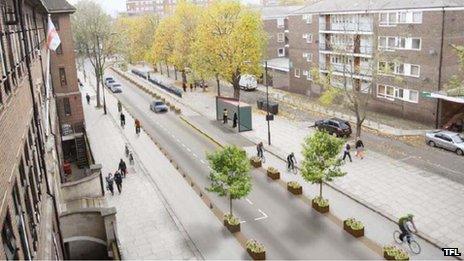Motorist group brands London cycling plan 'bonkers'
- Published

'Timid, half-hearted improvements are out' in terms of segregation, the mayor's plan says. This is an example of a semi-segregation plan in Camden
A plan for a "cycling revolution" in London has been branded "simply bonkers" by a car users group.
Roger Lawson of the Alliance of British Drivers said he objected to £913m being spent on a scheme that favours cyclists over other road users.
But the AA welcomed Boris Johnson's plan for a "Crossrail for bikes", a new cycle route more than 15 miles long.
President Edmund King said it would break down the "two tribes" attitude between drivers and cyclists.
'Unfair preference'
The route, detailed in The Mayor's Vision for Cycling in London, external will open in 2016 and will run through the western suburbs, central London and Barking.
The plan expounds a pro-cycling approach, borrowing from Amsterdam, Paris and Barcelona, with the aim of doubling cycling over the next 10 years.
The rhetoric of the document is unequivocal stating, for example:
Nothing must reduce cyclists' right to use any road.
No lorry should be allowed in London unless it is fitted with safety equipment to protect cyclists, and driven by someone fully trained in cycle awareness.
Timid, half-hearted improvements are out [re segregation] - we will do things at least adequately, or not at all.
We will ask for new powers to carry out camera enforcement of mandatory cycle lanes, to stop cars driving in them.
The response from Mr Lawson of the Alliance of British Drivers was that Mr Johnson's vision was "bonkers".

The super highway is part of the mayor's 10-year plan for the city
He said: "As a London taxpayer I strongly object to this waste of financial resources on a scheme that favours cyclists over other road users.
He said some of the more recent cycle superhighways had removed substantial road space, unfairly dedicating it to cyclists.
He added: "Why should they get preference rather than have to share road space with other road users?"
Steve McNamara of the Licensed Taxi Drivers' Association also criticised the apparent bias against commercial vehicles, calling it a "policy of lunacy".
But Mr King, AA president, said: "We believe that these plans will help to further break down some of the unnecessary "two tribes" attitudes between drivers and cyclists."
He said plans for dedicated cycle ways on busy roads such as Victoria Embankment would improve journeys for everyone, whether on two wheels or four.
'HS2 of cycling'
David Bizley, technical director of the RAC, said the proposals were welcome but his organisation is keen to understand how traffic will be affected.
He wondered if there was a danger the plan could be "the HS2 of cycling", with better value being delivered by smaller schemes.
Christopher Snelling, of the Freight Transport Association backed the plans, particularly the increased use of segregated cycle lanes.
He added that the more people use bikes instead of cars, the more space that will be left on the roads for freight vehicles.
Neil Greig of the Institute of Advanced Motorists welcomed changes to junctions and segregated cycle paths but said: "Any plan must improve safety for all roads and not just cycle superhighways.
"Poor driver and rider behaviour occurs all over the capital and to limit the improvements to main cycling routes does not go far enough."
- Published7 March 2013
- Published6 March 2013
- Published3 December 2012
- Published21 November 2012
- Published18 November 2011
- Published19 July 2010
- Published19 July 2010